Second Edition
Research - Wire-framing - Prototyping
Usability Testing - UI Elements
The Process
Project start date: 1/3/23
Project end date: 1/23/23
Background
This project was taken on as the first group project for the UX/UI UofM Bootcamp.
Goals
This study was prepared in order to inform the design and features of a virtual little library application.
More specifically, we would like to understand how readers procure books and their emotional experience in doing so. Our goal is to develop an app that will allow our users to donate, swap, and collect books in an accessible, convenient, and affordable way.
Research
Problem Statement
Book lovers, ready to pass on their books, have trouble doing so due to their desire for these treasured books to reach readers who will appreciate them.
The Solution
Second Edition, a book giving app, connects those giving away their books to people seeking their next great read; building a book loving community along the way.
Proto persona
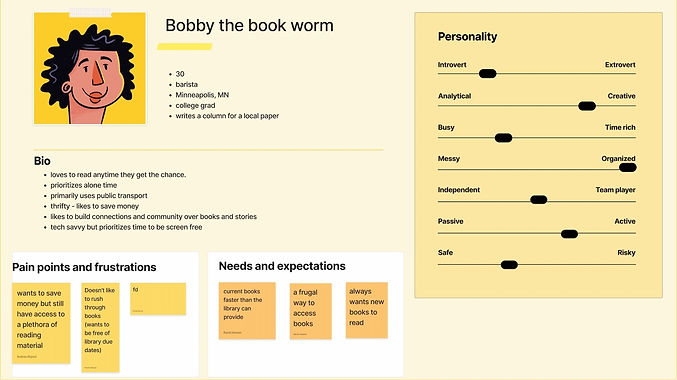
Research Questions
-
How do readers procure books and how often?
-
What barriers do they face when obtaining reading material?
-
What frustrations do they have with their current methods of access to reading material?
-
Are they interested in giving away their books? If so, how do they currently deal with unwanted books?
Hypothesis Statement
Readers wishing to rehome books want to do so in a way that gives them the gratification of giving books a new life.
Survey
We began our research by creating and distributing a google survey exploring participants relationship with books.
We received 54 responses.



Competitor Analysis

The process of doing a competitor analysis helped us get a feeling for what was and wasn’t working out in the world already. All of the apps we reviewed had their pros and cons, but ultimately we didn’t find any of these apps to be ideal for exchanging books.
User Persona
After spending time brainstorming we were able to synthesize our data into a defined user persona.
Bobby, our bookworm, represents the desires of our user from both the book giver and book seeker perspective.
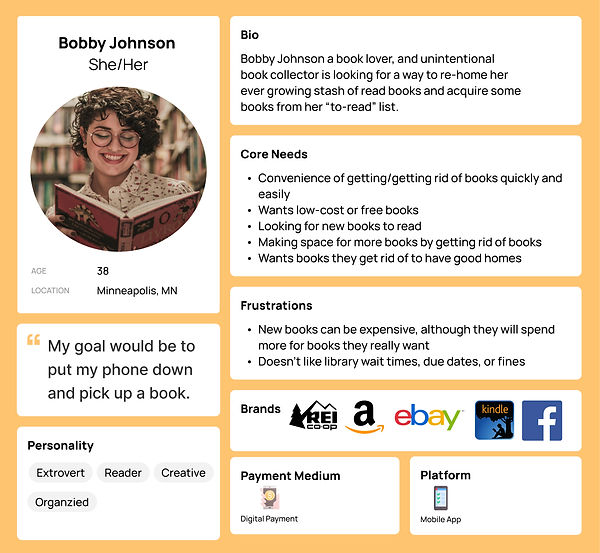
Feature Prioritization

After spending time brainstorming we were able to synthesize our data into a defined user persona.
Bobby, our bookworm, represents the desires of our user from both the book giver and book seeker perspective.
Storyboard
Through our journey map we wanted to follow our persona, Bobby, through the steps of downsizing their collection of books. Bobby begins the process overwhelmed by the task. Bobby is encouraged when realize they can simply scan books by ISBN in the Second Edition app. They’re also pleased their books will reach a community of book lovers. Bobby lists their books and gets a notification when someone is interested in their books. Bobby arranges a local meet up to hand off their books. Bobby is happy their books will be loved by the new recipient.



Sketches & Wireframes

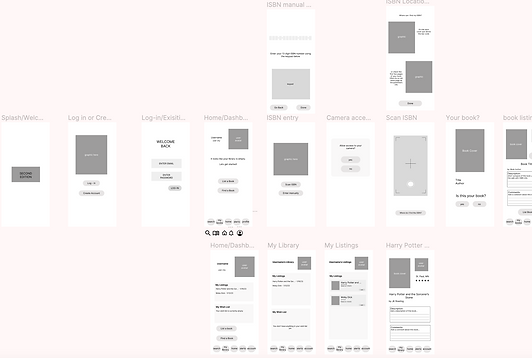
To begin prototyping, we made individual paper sketches outlining how each screen/page of our app should flow. We focused on a path of a “Book giver” user and came up with different ideas of how the user would go through the task step by step basing it off of our user flow. When creating the digital wireframes in Figma we all took inspiration from each individual paper sketches such as certain layouts, clickable button placements and features we wanted to include in the app. The tasks we wanted users to follow were to log into an existing account and to be able to upload a book listing for the book they wanted to give away.
Userflow
Starting to prototype our app we mapped out our user flow creating a step by step of a user’s journey through our app, Second Edition. This process made it easier to decide what features we wanted on our app.
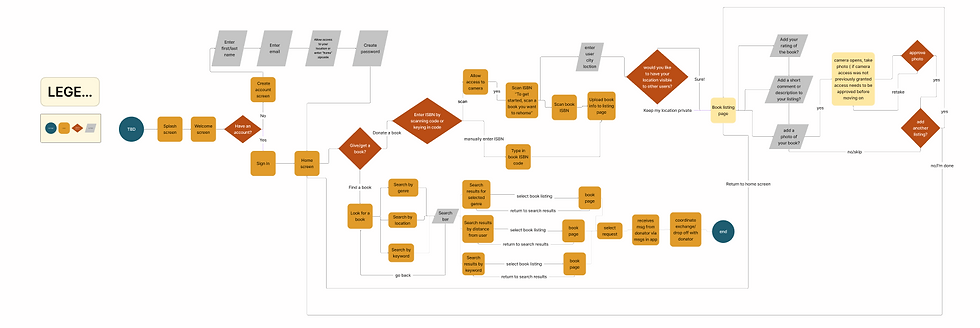






User Testing




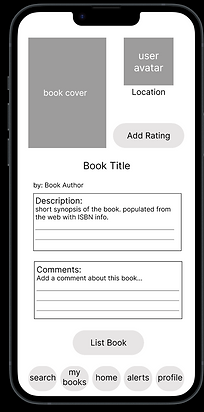


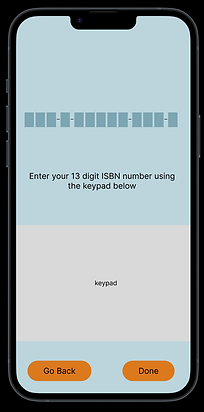
We conducted four user tests which brought us valuable insights and allowed us to iterate our designs to be more intuitive and streamlined.
We added an icon to the camera button when scanning an ISBN to make it easier to find and more obvious as the action required on that screen.
We moved our “where do I find the ISBN?” button from the camera scan page to the enter ISBN landing screen because we realized that users may need this information sooner in the process than we were initially providing it.
We cleaned up the Book listing preview screen as users testing the app became confused at this point about what they could and could not edit and what was required of them on this screen in order to list the book.
In the future, we hope to add to our manual entry ISBN feature. Books published since 2007 have 13-digit ISBN however books published before 2007 have 10-digit ISBN. You can use tools online to convert a 10-digit ISBN to a 13-digit ISBN and we would like to offer that option within the app in future iterations.
Final Prototype
*Mid-fi clickable prototype

After analyzing our user test results, we discovered some pain points our users faced such as:
-
not knowing where the final book list button was
-
how to identify the camera button
-
too much information on the book list page
Listening to the user’s feedback we made modifications to our prototype. We decided on:
-
making certain buttons bigger
-
adding icons to buttons such as the camera button to make it more noticeable
-
fixing fonts by changing size/colors.
-
changed the layout to our book listing page by just including the book blurb and removing the comment section.

Conclusion
There was so much more that we wish we could have done. We struggled with only being able to portray the book giver as the user throughout the process and would love the opportunity to flush out the app from the perspective of the book seeker. It would also be interesting to consider how to build a book-loving community within the app; a place where avid readers and book lovers could connect to discuss all things books. We envision users may also be from communities through in-person book exchanges and would consider building that into our app somehow. We also imagined a gamified aspect to our app that would reward users with discounts or points for use at booksellers when donating a required number of books. Other ideas included music media exchanges, and folding in a charitable or altruistic component.